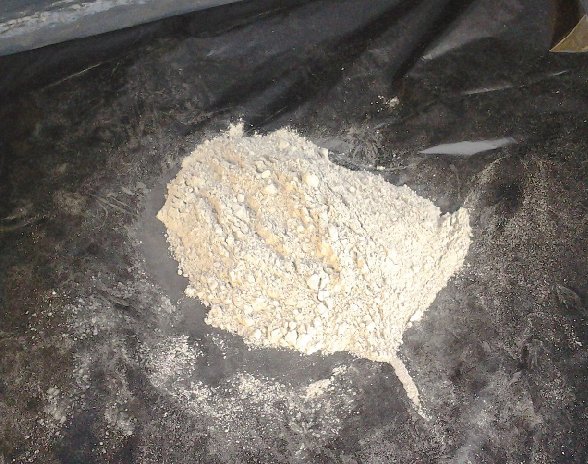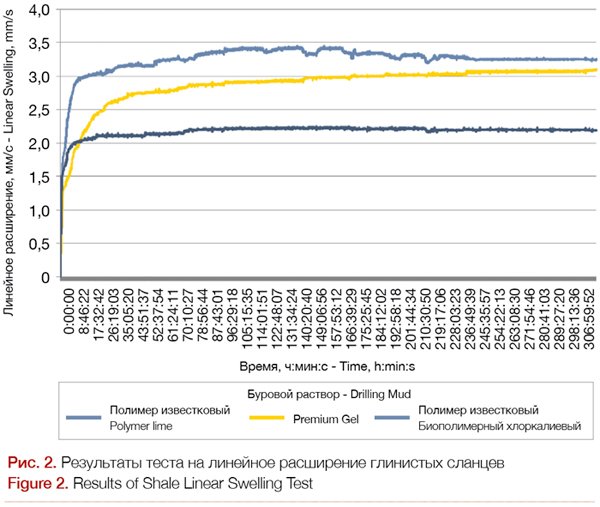Samaraneftegas: Hydrogel Based Mud in Direction and Horizontal Wells
The deposits of the Volga-Ural basin and, in particular, the Samara Region are mainly represented by anhydrites, greenish-gray and brown siltstone, and marl. The interlaying shale deposits become unstable and disintegrate when exposed to the drilling mud. Intense disintegration gives rise to a number of drilling problems.
When drilling directional and horizontal sidetracks, shale hydration causes the well to disintegrate and as a consequence, multiple reamings, overpulls and drags of the drilling tools, balling of cuttings, low penetration rate and reduced cutting lifting efficiency, poor cementing quality as well as formation contamination with the drilling mud. As a result highly inhibiting mud systems with improved composition, rheology and fluid loss characteristics should be used. Drilling mud inhibits and stabilizes the weak shale and saliferous rocks. The properties of the required mud include high inhibition, optimal rheology, low fluid loss and solids content and a high resistance to the polyvalent affect.
The objective is to identify the mud that is most effective in terms of reducing the drilling risk and reducing the time to takes to drill directionally and horizontal sidetracks.
Analysis of the Drilling Muds
A sidetracking analysis for the period from 2014 – 2015 was performed and the most common geological problems were identified. These take up 17% of the total sidetracking time and include: 65% – lost circulation, 34% – caving and 1% – gas-oil-water kicks (conditions incompatible with drilling) (see Figure 1).

Four wells in the South group of fields, which are similar in terms of geological profile and sidetrack length and were drilled using different types of drilling mud, were selected to carry out comparative analysis of the sidetracking times at Samaraneftegas fiekds (Table 1). As can be seen, the scheduled drill time was 14 days shorter (31 versus 45 days) when Premium-Gel mud was used. The drilling time with use of biopolymer potassium chloride, emulsion and polymer lime muds is longer by 3, 9 and 7 days respectively. The increase in the drill time is caused by problems due to the shale rock’s instability (slides, caving, lost circulation, overpulls and sticking of the drilling tools).

The implication is that Premium-Gel mud is much more stable in the process of drilling as evidenced by the analysis of the mud properties change while sidetracking. The important criterion of the mud efficiency when drilling through the shale deposits is fluid loss which was the lowest (1-1.5 cm3/30 min) for the above specified mud during drilling of the entire interval.
Material fluctuations in the density of the biopolymer potassium chloride and emulsion muds in the process of sidetracking indicate caving of the shale rocks when exposed to the drilling mud filtrate. Fluid loss of these muds is higher than that of the Premium-Gel mud and is 2.5–4.5 cm3/30 min.
Rheology and density of the polymer lime mud vary in a wide range during drilling, evidencing caving and considerable pH changes adversely affecting the active shale deposits. Due to high pH, the well walls adsorb Na+ cations. This increases shale hydration and contributes to collapsing.
As such, the Premium-Gel can be considered as the most stable based on the property change analysis carried out for several types of the drilling mud.
The following laboratory studies [1] were conducted to compare inhibiting properties of the drilling muds:
• Tula stage shale hydration (swelling) using Shale Swelling Unit;
• Tula stage shale core sample soaking using Soil Soaking Unit;
• Cuttings dispersing ability;
• Linear swelling of shales using Swellmeter OFITE for 7 days;
• Drilling mud wetting properties applying Russian National Research and Design Institute of Well Casing and Drilling Muds, RD 39-2-83).

The original core sample was ground to less than 0.25 mm grain size to study hydration. A two hour interaction of the mud filtrate and ground rock did not cause changes in the Unit readings (the pointer did not move from the zero point). This implies that in normal conditions fluid loss of three drilling muds is low and shale does not swell.
The soaking study findings proved that after a three day exposure of the core samples to the drilling muds in normal conditions, the samples remain stable as to the initial shape and weight, i.e. remained intact.
The cuttings dispersing ability was studied to compare the inhibiting properties of the muds. The study procedure is described below.
1. Tula stage core sample taken at 1,418.5m depth was ground to 2-5mm grain size.
2. Samples were dried at 105ºC.
3. Samples of specific weight were placed in the sealed boxes and filled with 145ml of drilling muds.
4. The boxes were then heated in the four-roller ovens for 8 hours at 80ºС and 25min-1 rotation speed.
5. After the boxes were drawn out and cooled, core samples were flushed with water, sieved through 1mm mesh size sieve and dried at 105ºC.
The study results evidence that core sample material loss constituted 0.3, 2.52 and 6.54% when Premium Gel, biopolymer and potassium chloride muds (respectively) were used. It shows that Premium Gel mud has the best inhibiting properties as only 0.3% of cuttings was dispersed or reduced to less than 1mm grain size.
To determine shale linear swelling, ground Tula stage core material was compacted in the compressor at the pressure found at 1,500m depth for 1 hour. The compacted samples were then placed in Swellmeter unit simulating borehole conditions and samples monitored for 7 days.
The test results imply that the Tula stage shale (taken at 1,418.5 m depth) was least impacted by the biopolymer potassium chloride mud. Premium-Gel was at the second place and lime mud caused the highest linear swelling of the sample. Results can be found in Figure 2.

To determine the wetting properties of the drilling muds [2], compacted cylindrical samples of Sarigyukh bentonite 20mm in diameter and 32mm in length were weighted and placed in three muds. In 4 hours the samples were extracted and flushed with water. The final weight of the samples was then measured. Data were used to calculate the following parameters.
The wetting property parameter for every drilling mud analyzed was calculated applying the following equation:
![]() (1)
(1)
Where ?t – current wetting rate, cm/h; К – sh¡ale colloidal factor determined using methylene blue; τ – sample wetting time, h.
Current wetting rate
 (2)
(2)
Where Р2, Р1 – weight of the wet and original sample respectively, g; К1 = 1 cm – factor [1].
The lowest absolute wetting of 0.78 cm/h was registered for Premium-Gel mud as opposed to 1.85 cm/h for biopolymer potassium chloride mud and 2.1 cm/h for polymer lime mud.
Studies for three mud systems used in Samaraneftegas fields applying five methods show that Premium-Gel mud has the best inhibiting properties (Table 2). This type of the drilling mud is the most effective in terms of drilling risk reduction while drilling directional and horizontal sidetracks in unstable shales.

Premium-Gel Drilling Mud
Premium-Gel mud developed by Bento Technology is based on three chloride salts (CaCl2, MgCl2, KCl), caustic soda and water. These components contribute to high rheology of the mud due to absence of colloidal phase. The following agents are used as stabilizers: starch (to stabilize fluid loss), lubricant (to control friction coefficient and to add drilling tool lubricating ability), biocides (to prevent bacterial attack) and a defoaming agent (to prevent mud foaming).
Premium-Gel is a highly inhibiting hydrogel-based mud system intended for drilling in high polyvalent and gas aggressive environments. The mud ensures the stability of active and weak shales, reduction of aquifer permeability, quality borehole cleanout and producing reservoir containment. Due to low content of solids, including colloidal phase, and low fluid loss (1-2 cm3/30 min), Premium-Gel can be used for reservoir drilling-in.
Conclusion
The geological problems arising at the Samaraneftegas fields for the period of 2014-2015 were analyzed, laboratory studies of various types of the drilling muds were performed and mud affect on the borehole stability, accident rate and drill time was studied.
The entire well drill time highly depends on the drilling mud selected for the difficult drilling zone.
The results of the analysis and the studies showed that the Premium-Gel mud has the best rock inhibiting properties and is the most effective in terms of reducing the drilling risk while drilling directional and horizontal sidetracks in unstable shales. Use of this drilling mud can potentially reduce the dill time by approximately 10% to the reduced geological risk.
References
1. Koshelev V.N., Gvozd M. S., Rastegaev B. A. et al., Selection of Drilling Mud for Drilling in Shales // Drilling and Oil. 2015, no. 9, p. 27.
2. RD 39-00147001-773-2004, Control Methods for Drilling Fluids Parameters, Moscow, 2004.
S. O. Kisevela, V. V. Poroshin, V. A. Yashkov
(Samaraneftegas)
The article was published in the ROSNEFT Scientific and Technical Newsletter (Nauchno-technicheskiy Vestnik OAO “NK “Rosneft”) No.1, 2016, pp.16.
Printed with permission from the Editorial Board.












